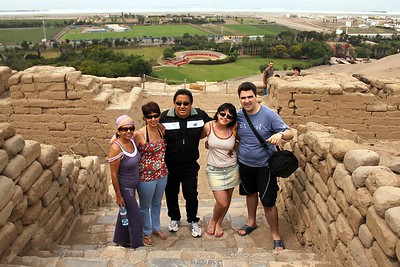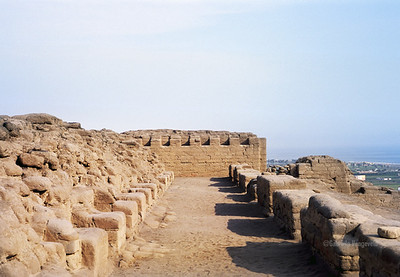Eight centuries before the rise of the Inca empire, two powerful kingdoms ruled the Andean world with their magnificent cities, temples and roads. To the south, were the Tiahuanaco, with a great ceremonial center in the vicinity of Lake Titicaca.
In the central part the Wari flourished with an immense urban center, with palaces, residences and majestic temples that characterized a more urban and militaristic society.
The archaeologist José Ochatoma explains that the Inca state lasted barely 100 years, while the Wari Culture in Perú lasted almost 400, it flourished between 600 and 1000 A.D. like Tiahuanaco, a neighboring kingdom, in present-day Bolivia. These two civilizations set the stage for later Andean empires.
What is the Wari Culture in Perú?

Cultura Wari 
Cultura Wari
The Huari or Wari Culture in Perú was a pre-Columbian Andean civilization that flourished approximately between the 7th and 13th centuries A.D.C. in the territories of the current Peruvian departments of Lambayeque, Moquegua and the jungle of the department of Cusco.
It was an eminently military and religious culture.
From the Wari Culture in present-day Perú Peru there are various archaeological sites, of which the ancient city of Wari (600-1100 AD) is the most important, since it was the capital of an empire that covered a good part of the coast and the Peruvian highlands.
These ruins are located 22km northwest of the current city of Ayacucho between 2,900 and 2,600 meters above sea level.
How was the Wari Culture discovered in Perú?
The remains of the Wari Culture in Perú were known to the Spanish conquerors, as evidenced by chronicles of the time (such as those of Pedro Cieza de León).
But the one who carried out the first formal archaeological studies that brought the Wari to light was Julio César Tello (1880-1947), a Peruvian researcher who is also credited with the rediscovery of the Chavín and Paracas cultures, as well as the creation of the Museum of Peruvian Archeology.
Wari society
The Huari society formed a Pan-Andean state that at its peak encompassed the areas of Peru, Bolivia and northern Chile.
It is assumed that, in its heyday, the Huari Empire would have consisted of the fusion of this culture with another equally powerful but located further south, the Tiahuanacotas. Thus, the Tiahuanaco-Huari Empire would have arisen.
The Wari Civilization would have been a militaristic and expansive culture, which conquered the neighboring cultures of the high Andean and coastal regions.
On the other hand, the Tiahuanacos created a theocratic state of the southern Andes, which was integrated into the empire in a peaceful and commercially active way.
Organization
The Wari Civilization created administrative institutions, in addition to keeping a hierarchical structure in the centers they founded. They had warehouses, artisan workshops and housing centers.
This culture introduced novel notions and patterns in the formation of cities in the Andes. The centralist conception allowed to control the population and the fulfillment of its activities. The centers were organized along a north-south axis and were built close to main roads that formed a whole road network. However, only the elite resided in the cities; ordinary people came only to fulfill their tasks or participate in religious ceremonies and lived in the surrounding rural areas. Among the main centers of Wari culture we find, near Cuzco, the provincial capital Piquillacta, which had walls up to 12 meters high and which occupied an area of almost two square kilometers.
All this within an organization based on reciprocity with the populations they assimilated. That is why the state of the Wari Civilization organized parties and entertainments that later allowed him to obtain work benefits. Also in such a complex empire, it was necessary to create a method for accounting and control. Archaeological finds have shown that the inhabitants of the Wari culture already used a type of quipu and that they developed a network of roads that connected the capital with regional centers.
Wari Religion
The Wari had a syncretic religion, the result of the mixture between the cults practiced in Ayacucho, Nazca and Pachacamac.
The Wari religion was also used as a tool for the expansion and colonization of the surrounding towns, despite the fact that in many ways the Wari religion was similar to that of other towns, such as the Tiahuanacos.
Wari astronomy
Like many other ancient cultures, that of the Huari felt great interest in the stars and the sky.
The discovery of D-shaped structures in various archaeological sites suggests that they would have served as an observatory and / or place of ritual ceremonies. It is probable that the urban elite dedicated themselves to the interpretation or the cult of the stars.
Economic activities
Since we speak of an imperial culture, its economy basically consisted of the looting, domination and absorption of neighboring peoples.
Given the imperial character of this State; the Wari’s economic policy was oriented to exploit the colonized peoples.
The archaeologist Luis Guillermo Lumbreras, referring to this aspect, points out: «The policy of the Ayacuchanos seems to have been oriented to obtain the maximum of agricultural profits, in the colonized valleys, both in the mountains and on the coast. Taking advantage of the local agrarian experience, as well as that of all the conquered territories, a vast hydraulic program was developed, enabling new lands in each valley and rationalizing planting and harvesting (….) The construction of canals, water reservoirs and other agricultural services were also used for urban maintenance, which was also complemented with roads throughout the Empire ”.
Wari ceramics
The Wari People cultivated ceramics enormously and profusely, in which the very different periods of their culture are evidenced.
According to the evidence, the ceramics of the Wari People were marked by different influences. Researchers, depending on the time and place in which it was developed and the characteristics it presents, have divided the ceramics of the Wari culture into various phases or styles, among which Chaquipampa, Conchopata and Robles Moqo stand out.
The Wari People manufactured fine ceramics that were oriented to the use of the elite, in addition to serving for the dissemination of religious ideas. They also made another for domestic use.
Wari clothing
The textile activity of the Wari reached a good degree of development. They used cotton, alpaca and vicuña wool as raw materials, and made with them colorful clothes that were used both for the daily and for religious rites and ceremonial acts.
His true specialty was tapestry making, predominantly reds, bright blues, yellows, golds, and whites, in which they represented mythical beings of their religion, as well as motifs with snakes, cats and birds.
The fabrics were characterized by a great chromatic display. Red, bright blue, yellow, gold and white predominated. In addition to tapestries, they made girdles, bags, uncos or sleeveless nightgowns.
His textile samples, such as girdles, bags and sleeveless nightgowns, have been found in different places of the Peruvian territory.
Architecture of the Wari Culture
The Wari culture built various urban centers along its main roads, based on a north-south axis.
Its architectural style is considered foundational to the traditional style of the Andean populations.
Its cities basically consisted of urban centers dedicated to the elites and the powerful, who during the day welcomed citizens from rural hamlets.
The latter came to the cities to fulfill obligations, attend religious rites or pay tribute.
Some important Huari cities, such as the provincial capital Piquillacta, near Cusco, had high walls up to 12 meters high, with geometric buildings and a total area of almost two square kilometers.
In the central area, as in the capital city, there were huge terraces and walled enclosures (made of stone and mud), equipped with interior buildings, many of which served as tombs for royalty.
It is estimated that at its peak, the city of Wari was home to between 10 and 21 thousand inhabitants.
The City of Wari
The capital of the Wari culture was located northeast of Ayacucho. The urban area occupied between 1000 and 1500 hectares. In the central area there were large terraces and walled enclosures with interior buildings. Despite having capacity for between 35 and 70 thousand people, it only had a population of between 10 and 21 thousand inhabitants. It was divided into neighborhoods: Checohuasi, Moraduchayoc, Capillayoc and Ushpa Coto.
Expansion of Wari Culture
Shortly after its inception, the Wari culture spread south to Acarí, along the north coast to the Santa Valley and through the mountains to the Callejón de Huaylas. With the consolidation of the empire, it managed to spread from Sicuani and the Arequipa region to Cajamarca through the mountains and from Ocoña and Sihuas to Lambayeque along the coast.
The evidences reflect a great expansion of the Wari culture, but also show that it was not only a military conquest but rather a process of assimilation of these peoples to the administration of the Wari culture and other patterns of their culture, especially religion and urbanism.
End of the Wari culture
Empires are powerful insofar as they keep peoples subdued, but when they are liberated, they decline.
The Wari Culture was not oblivious to the previous statement. The specialists point out that several of the colonial cities of Wari, called regional capitals, were acquiring political and economic importance, until reaching a situation similar to the metropolitan city; it was in those moments when these colonies began to free themselves from the imperial Wari control.
This process was repeated successively one after another, until reaching the point where the metropolitan city of Wari became a white elephant, it was then that its ruin came. All this happened towards the end of the 11th century.
The reason for the end of the Huari culture is not known for sure. It is not risky to suppose that such a vast empire would have seen colonial cities arise that would compete with the capital in abundance and importance, eventually leading to internal wars.
If to this are added certain pressing climatic conditions, which would have forced the settlers to compete for resources, it is understandable that the Empire has disintegrated into a set of provincial manors or fiefdoms.










